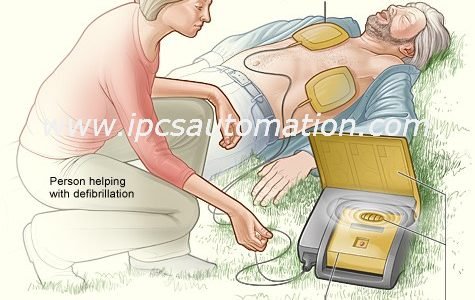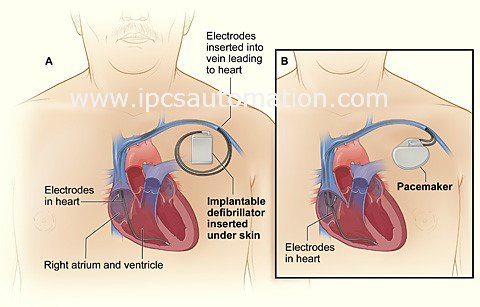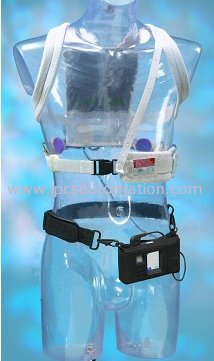
Many heart patients die due to cardiac arrest which occurs without any warning. So an embedded system was introduced into some medical devices which are used to detect cardiac abnormalities which include, the irregularity of heartbeat and are diagnosed before the contingency of the heart attack in order to avoid the deadly cardiac arrest to a major extent. Such embedded medical devices include defibrillator which is a machine used to monitors a patient’s heartbeat for an irregular pattern and generally shocks the heartbeat back to its normal pattern when an abnormal heartbeat is detected.
TYPES OF DEFRIBRILLATORS
- Automated External Defribrilators (AED’s)
- Implantable Cardioverter Defribrillators (ICD’s)
- Wearable Cardioverter Defribrilators (WCD’s)
Automated External Defribrilators (AED’s):
An AED is a lightweight, battery-operated, portable device that checks the heart’s rhythm and sends a shock to the heart to restore a normal rhythm. The device is used to help people having sudden cardiac arrest.
Sticky pads with sensors, called electrodes, are attached to the chest of someone who is having cardiac arrest. The electrodes send information about the person’s heart rhythm to a computer in the AED. The computer analyses the heart rhythm to find out whether an electric shock is needed. If needed, the electrodes deliver the shock.
Advantages:
- AEDs can save the life of someone having sudden cardiac arrest, when the heart suddenly and unexpectedly stops beating.
- AEDs can be used for adults, as well as for children as young as 1 year old. Some devices have pads and cables designed especially for children.
- Doing cardiopulmonary resuscitation, or CPR, on someone having sudden cardiac arrest also can improve his or her chance of survival. Learn more about using an AED in an emergency.
Implantable Cardioverter Defribrillators(ICD’s)::
ICDs are placed surgically in the chest or abdomen, where it checks for arrhythmia. Arrhythmia can interrupt the flow of blood from your heart to the rest of your body or cause your heart to stop. The ICD sends a shock to correct the arrhythmia.

An ICD can give off a low-energy shock to speed up or slow down an abnormal heart rate or a high-energy shock, which can correct a fast or irregular heartbeat. If the low-energy shocks do not restore your normal heart rhythm, the device will switch to high-energy shocks for defibrillation. The device also will switch to high-energy shocks if your ventricles start to quiver rather than contract strongly. ICDs are similar to pacemakers, but pacemakers deliver only low-energy electrical shocks.
ICDs have a generator connected to wires to detect your heart’s pulses and deliver a shock when needed. Some models have wires that rest in one or two chambers of the heart. Others do not have wires threaded into the heart chambers but rest on the heart to monitor its rhythm.
The ICD can also record the heart’s electrical activity and heart rhythms. The recordings can help your doctor fine-tune the programming of your device so it works better to correct irregular heartbeats. Your device will be programmed to respond to the type of arrhythmia you are most likely to have.
Advantages:
- It plays major role in save life of victims who suffered by Sudden Cardiac arrest, arrhythmia due to treatment of heart attack and genetic disorders, neuromuscular disorder, Poor heart function
Wearable Cardioverter Defribrilators (WCD’s):
WCDs have sensors that attach to the skin. They are connected by wires to a unit that checks your heart’s rhythm and delivers shocks when needed. Like an ICD, the WCD can deliver low- and high-energy shocks. The device has a belt attached to a vest and is worn under your clothes. Your doctor will fit the device to your size. The device is programmed to detect a particular heart rhythm.

The sensors detect when an arrhythmia occurs and notifies you with an alert. You can turn off the alert to prevent a shock if not needed, but if you do not respond, the device will administer a shock to correct the rhythm. Typically, this happens within one minute. The device can deliver repeated shocks during an episode. After each episode, the sensors must be replaced. The device can also send a record of your heart’s activity to your doctors.
Advantages:
- WCDs are used to protect against sudden cardiac arrest in certain circumstances, such as if the victim are at risk of arrhythmia for just a short time. This might occur under the conditions such as heart attack, heart transplantation, during the replacement of ICD.
